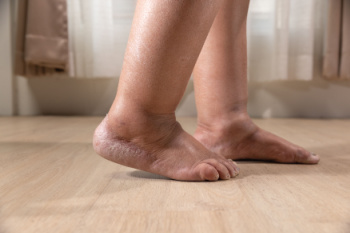Connect With Us
Blog
Items filtered by date: August 2025
Gout Pain Can Be Managed
Why Feet May Ache More After Dark

Pain that sets in during the evening or overnight can have many triggers. Irritated nerves may create tingling or burning once the feet are still. Circulation changes in a reclined position can lead to throbbing or heaviness. Inflammation from arthritis may stiffen joints during hours of rest, while strain in the plantar fascia can cause lingering soreness from the day’s activity. Muscle cramps, often linked to dehydration or low mineral levels, may jolt you awake. Even blankets pressing on the toes can aggravate tender spots. Because these sensations can stem from multiple causes, finding lasting relief depends on identifying the source. Solutions might include specific exercises, wearing better footwear, or podiatric treatment. If foot pain regularly interferes with rest, it is suggested that you see a podiatrist for a full evaluation and targeted care.
Foot Pain
Foot pain can be extremely painful and debilitating. If you have a foot pain, consult with Jeffrey Rosenblatt, DPM from New York. Our doctor will assess your condition and provide you with quality foot and ankle treatment.
Causes
Foot pain is a very broad condition that could be caused by one or more ailments. The most common include:
- Bunions
- Hammertoes
- Plantar Fasciitis
- Bone Spurs
- Corns
- Tarsal Tunnel Syndrome
- Ingrown Toenails
- Arthritis (such as Gout, Rheumatoid, and Osteoarthritis)
- Flat Feet
- Injury (from stress fractures, broken toe, foot, ankle, Achilles tendon ruptures, and sprains)
- And more
Diagnosis
To figure out the cause of foot pain, podiatrists utilize several different methods. This can range from simple visual inspections and sensation tests to X-rays and MRI scans. Prior medical history, family medical history, and any recent physical traumatic events will all be taken into consideration for a proper diagnosis.
Treatment
Treatment depends upon the cause of the foot pain. Whether it is resting, staying off the foot, or having surgery; podiatrists have a number of treatment options available for foot pain.
If you have any questions, please feel free to contact our office located in Brooklyn, NY . We offer the newest diagnostic and treatment technologies for all your foot care needs.
Risks and Complications of Broken Ankles

A broken ankle is more than just a simple fracture. Without proper treatment, it can lead to long-term problems that affect mobility and quality of life. One possible complication is poor bone healing, which can result in chronic pain or joint instability. Damage to surrounding ligaments, tendons, or blood vessels may also occur, increasing recovery time and impacting function. Infections can develop after surgery or when the skin around the injury is damaged. Arthritis in the ankle joint is another potential long-term outcome, especially if the break involves the joint surface. Early and accurate treatment is essential to reduce these risks and promote full recovery. If you have suffered an ankle fracture or continue to experience pain and swelling after an injury, it is suggested you consult a podiatrist for appropriate care.
Broken ankles need immediate treatment. If you are seeking treatment, contact Jeffrey Rosenblatt, DPM from New York. Our doctor can provide the care you need to keep you pain-free and on your feet.
Broken Ankles
A broken ankle is experienced when a person fractures their tibia or fibula in the lower leg and ankle area. Both of these bones are attached at the bottom of the leg and combine to form what we know to be our ankle.
When a physician is referring to a break of the ankle, he or she is usually referring to a break in the area where the tibia and fibula are joined to create our ankle joint. Ankles are more prone to fractures because the ankle is an area that suffers a lot of pressure and stress. There are some obvious signs when a person experiences a fractured ankle, and the following symptoms may be present.
Symptoms of a Fractured Ankle
- Excessive pain when the area is touched or when any pressure is placed on the ankle
- Swelling around the area
- Bruising of the area
- Area appears to be deformed
If you suspect an ankle fracture, it is recommended to seek treatment as soon as possible. The sooner you have your podiatrist diagnose the fracture, the quicker you’ll be on the way towards recovery.
If you have any questions, please feel free to contact our office located in Brooklyn, NY . We offer the newest diagnostic and treatment technologies for all your foot care needs.
Causes of Ankle Pain From Running

Ankle pain from running can result from several foot and ankle conditions. Repeated impact and overuse may lead to strained muscles or sprained ligaments, especially if the foot lands awkwardly during a run. Stress fractures can occur when small cracks form in ankle bones due to constant pounding on hard surfaces. Tendonitis is another cause of ankle pain, affecting the peroneal, posterior tibial, or Achilles tendons. This condition may be due to improper form, poor footwear, or overtraining. Some runners also develop arthritis in the ankle joint, leading to stiffness, swelling, and pain during motion. Biomechanical issues, such as weak ankles or overpronation, may cause instability and increase the risk of recurring injury. A podiatrist can assess foot structure, gait mechanics, and joint function to determine the cause of ankle pain. Treatment options include custom orthotics, bracing, or in some cases, surgery. If you are experiencing ankle pain from running, it is suggested that you make an appointment with a podiatrist for an exam, a diagnosis, and treatment.
Ankle pain can have many different causes and the pain may potentially be serious. If you have ankle pain, consult with Jeffrey Rosenblatt, DPM from New York. Our doctor will assess your condition and provide you with quality foot and ankle treatment.
Ankle pain is any condition that causes pain in the ankle. Due to the fact that the ankle consists of tendons, muscles, bones, and ligaments, ankle pain can come from a number of different conditions.
Causes
The most common causes of ankle pain include:
- Types of arthritis (rheumatoid, osteoarthritis, and gout)
- Ankle sprains
- Broken ankles
- Achilles tendinitis
- Achilles tendon rupture
- Stress fractures
- Tarsal tunnel syndrome
- Plantar fasciitis
Symptoms
Symptoms of ankle injury vary based upon the condition. Pain may include general pain and discomfort, swelling, aching, redness, bruising, burning or stabbing sensations, and/or loss of sensation.
Diagnosis
Due to the wide variety of potential causes of ankle pain, podiatrists will utilize a number of different methods to properly diagnose ankle pain. This can include asking for personal and family medical histories and of any recent injuries. Further diagnosis may include sensation tests, a physical examination, and potentially x-rays or other imaging tests.
Treatment
Just as the range of causes varies widely, so do treatments. Some more common treatments are rest, ice packs, keeping pressure off the foot, orthotics and braces, medication for inflammation and pain, and surgery.
If you have any questions please feel free to contact our office located in Brooklyn, NY . We offer the newest diagnostic tools and technology to treat your foot and ankle needs.
Recognizing When Swelling in Your Feet and Ankles Is Serious

It is common to experience occasional swelling in your feet and ankles, especially after standing or walking for long periods of time. Often, this swelling results from fluid retention and resolves with rest and elevation. However, persistent or sudden swelling may signal a more serious concern. When swelling is accompanied by pain, redness, warmth, or difficulty walking, it could indicate a medical condition requiring prompt care. Blood clots, infections, heart problems, kidney issues, or venous insufficiency are possible causes that should not be ignored. Swelling that affects only one leg, worsens throughout the day, or appears without a clear reason should raise concern. People with diabetes, heart disease, or circulation problems should monitor swelling closely, as they are at a higher risk for complications. If swelling limits your daily activities or causes discomfort, it is suggested you schedule a visit with a podiatrist for a proper diagnosis and appropriate treatment.
Swollen feet can be a sign of an underlying condition. If you have any concerns, contact Jeffrey Rosenblatt, DPM of New York. Our doctor can provide the care you need to keep you pain-free and on your feet.
Swollen feet are a common ailment among pregnant women and people who stand or sit for extended periods. Aging may increase the possibility of swollen feet and patients who are obese often notice when their feet are swelling too. There may be medical reasons why swollen feet occur:
- Phlebitis - A condition that causes the veins to become inflamed and can also cause leg pain.
- Liver disease - This may lead to low blood levels of albumin which is a protein. This can cause fluid in the blood to pass into the tissues and several areas of the body can become swollen.
- Heart failure - When the heart doesn’t pump properly the blood that is normally pumped back to the heart can pool in the veins of the legs causing swollen feet.
- Kidney disease - One of the main functions of the kidneys is releasing excess fluid in the body. This type of condition can make it difficult for the kidneys to function properly, and as a result the feet may become swollen.
- Deep-vein thrombosis (DVT)- This is a serious condition where blood clots form in the veins of the legs. They can block the return of blood from the legs to the heart which may cause the feet to swell. It is important to be treated by a podiatrist if this condition is present.
Swollen feet can also be caused by bone and tendon conditions, including fractures, arthritis, and tendinitis. Additionally, there may be skin and toenail conditions and an infection may cause the feet to swell. Patients who take medicine to treat high blood pressure may be prone to getting swollen feet.
Many patients elevate their feet to help relieve the swelling and this is generally a temporary remedy. When a podiatrist is consulted the reason behind the swelling can be uncovered and subsequently treated.
If you have any questions please contact our office located in Brooklyn, NY . We offer the newest diagnostic and treatment technologies for all your foot and ankle needs.
Arthritis Can Cause Pain in the Feet and Ankles
Blog Archives
- October 2025
- September 2025
- August 2025
- July 2025
- June 2025
- May 2025
- April 2025
- March 2025
- February 2025
- January 2025
- December 2024
- November 2024
- October 2024
- September 2024
- August 2024
- July 2024
- June 2024
- May 2024
- April 2024
- March 2024
- February 2024
- January 2024
- December 2023
- November 2023
- October 2023
- September 2023
- August 2023
- July 2023
- June 2023
- May 2023
- April 2023
- March 2023
- February 2023
- January 2023
- December 2022
- November 2022
- October 2022
- September 2022
- August 2022


